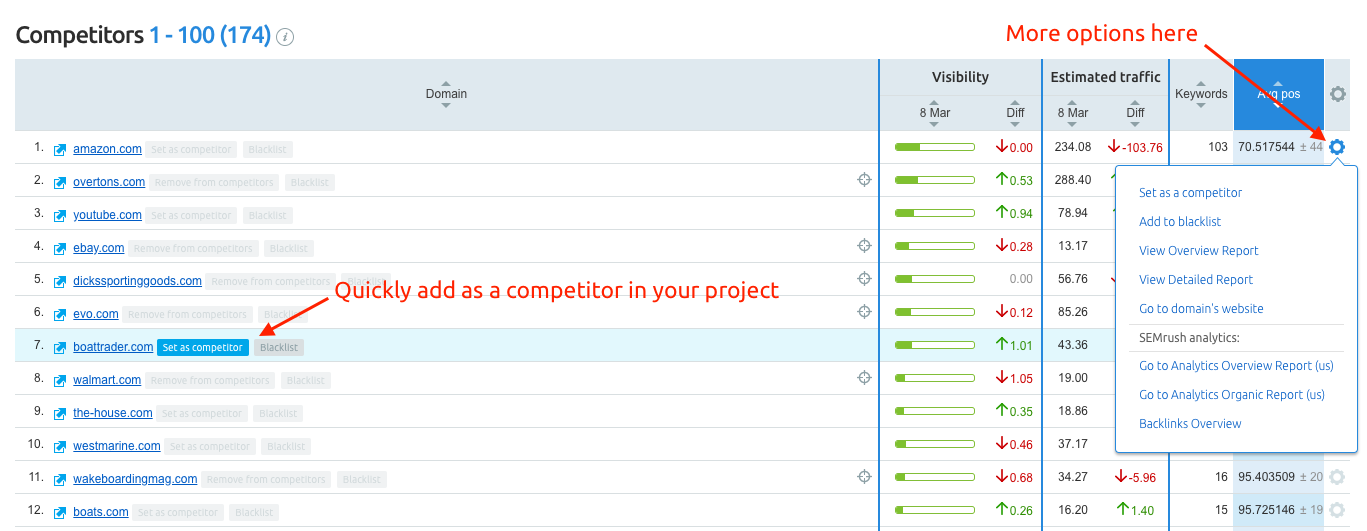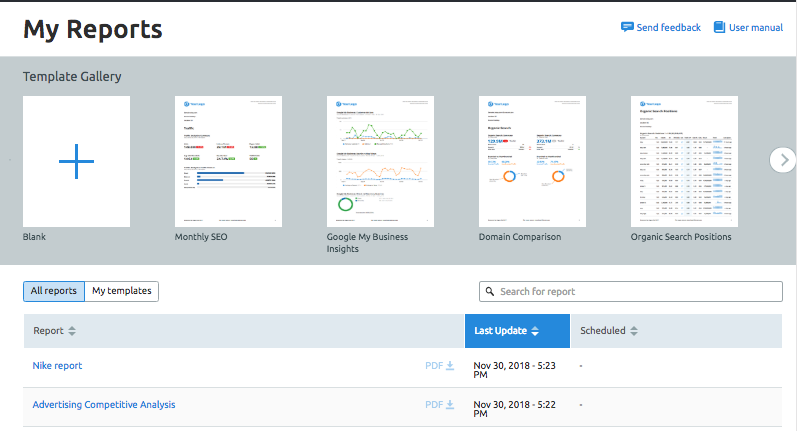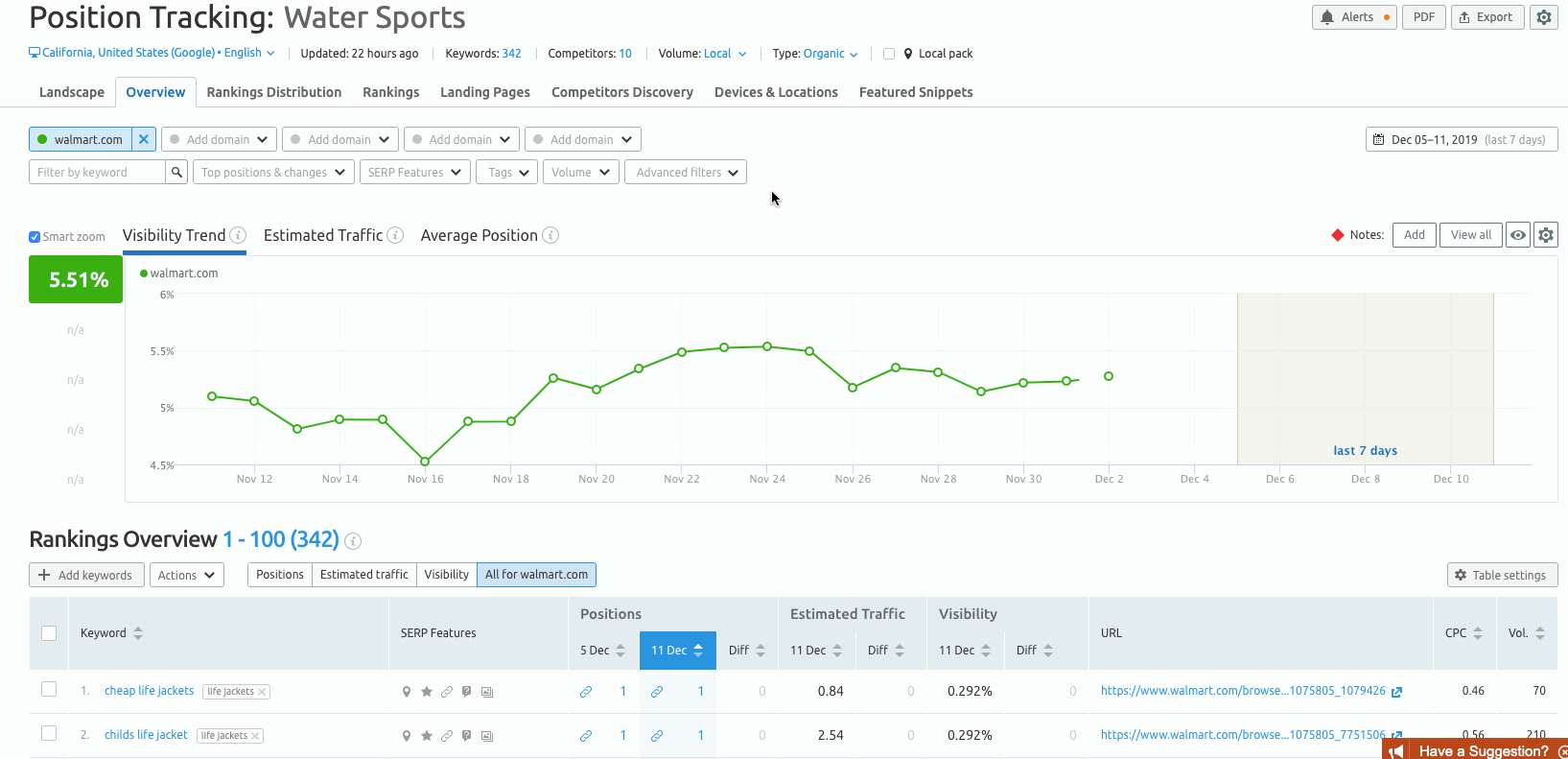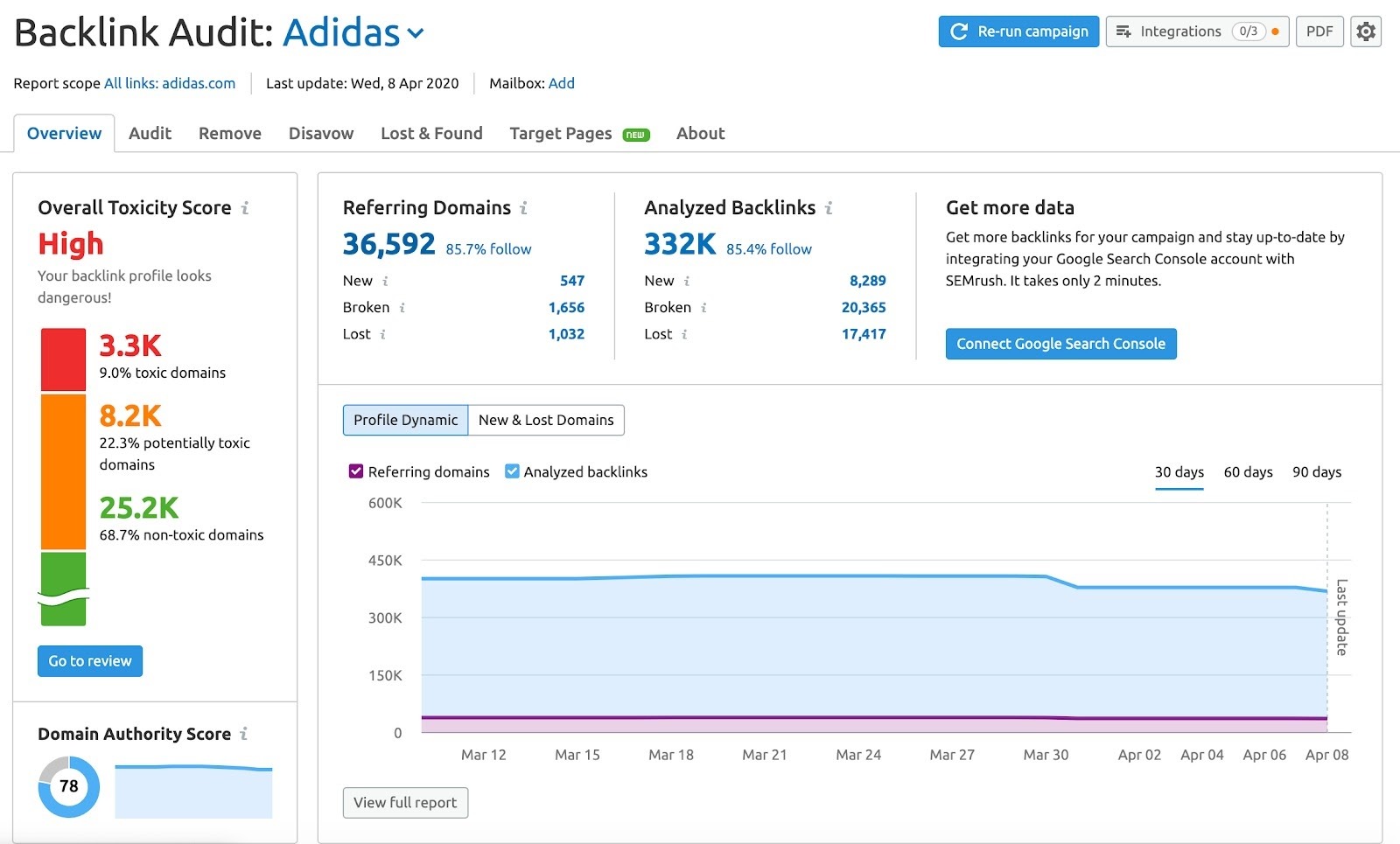Standing out amongst two million daily blog posts is no easy feat. Luckily with the right tools, you can be a little closer to the top of that pile. This SEMrush review spells out the most essential features and tools that you need today.
What is SEMrush? SEMrush is an ‘online visibility management and content marketing SaaS platform.’ If you’re not an SEO or CMS expert, here’s what that means in plain English. (If you’re a freelancing SEO pro, we’d love to feature you on our podcast!)
SEMrush provides tools and reports to help you increase the visibility of your content or website. The tools cover SEO (search engine optimization), content management, advertising, social media, and competition research.
The SEMrush suite isn’t cheap. At almost $100 per month for the most affordable plan. However, you can try it free for 14 days.
SEMrush is for:
- Freelancers
- Writers
- Solopreneurs
- Marketers
SEMrush features help clients increase organic traffic, increase domain authority, and find organic leads and sales. Let’s dive into this SEMrush review to get a deeper understanding of the tools you can’t miss out on.
A Little Keyword Magic
Keywords aren’t everything in SEO, but they’re pretty close. Google and other search engines crawl your site for keywords to categorize it. So, when a potential lead searches for ‘SEMrush review,’ they’ll hopefully stumble on this article.
If you already know the basics of SEO, you understand that you can’t pick any keyword. It helps to think of keywords as social media hashtags. They help the algorithm promote your post for users that search for that exact term or related terms.
But as the number of posts under a hashtag increases, it becomes increasingly harder to stand out using that tag. On the other hand, hashtags that are seldom used are not useful because no one is searching for them. The aim is to find the sweet spot – a keyword that isn’t too popular, but is well known (or at least will be).
Of course, the utility of a hashtag or keyword is also tied to what your audience is searching for. While a keyword may have a low turnout, that doesn’t mean a high percentage of your audience isn’t checking up on it.
It seems like a lot to bear in mind when keyword searching, and it gets more complicated. That’s where SEMrush’s Keyword Magic tool comes in.


Keyword Magic Tool
The keyword magic tool is the largest keyword database on the market. That’s no small feat. With over 20 billion keywords, it’s hard to miss a growing niche with the KM tool.
By contrast, the Ahrefs keyword index tool only has access to 7.8 billion keywords. That’s less than half the reach of the KM tool.
The KM tool is the starting point for content. Building your content around a (growing) demand for specific content is foundational.
You want to avoid putting in hard work on an article that never sees the light of day. And what better way to predict what people want to see than to understand what they are searching for?
SEMrush keyword research tools are incredibly easy to use. Every keyword search and country specification yields every possible connection. The KM tool produces at least 20 million relevant keywords connected to your search.
Each keyword can be ranked and filtered by:
- Search volume
- Search trend (line graph of volume change over time)
- Keyword difficulty (the chance of your outperforming your competitors on that keyword)
- Ad bidding competition level
- Cost per click
- SERP feature potential (chance of acquiring a SERP feature)
- Click potential (likelihood of user clicks if ranked in the top 20)
- Top competitors (top domains ranking for that keyword).
You can also save keywords from tracking over time. That helps you update keywords or quickly access content ideas later on. You can create up to 50 lists for each keyword topic.
Not only is this tool exhaustively useful, but it also siphons from 142 different databases around the world. Why does that matter?
Jumpshot Accuracy
For NBA fans, this is unfortunately not where we abandon talking about SEMrush and focus on hoops. But there is a little irony in the name.
Jumpshot was a keyword tool hosted by Avast that recently shut down. Since many other SEO tools like Ahrefs or Moz relied on their database, they began producing odd results.
The publicity earlier this year was not beneficial for business. But it became apparent that those databases updated keyword volume monthly.
In a world where new trends and words rise and fall in weeks or days, monthly updates just don’t cut it. SEMrush’s KM tool, however, is continuously updated.
This is important because a keyword search tool that isn’t up to date is not very useful. The value of a keyword search tool is based on its accuracy and reliability.
What’s Your Position?
No SEMrush review would be complete without assessing their position tracking tool. SEO position tracking means monitoring your site’s rankings over time. By doing so, you can find market gaps or areas of comparison to your competitors.
The SEMrush position tracking tool measures different variables over time, such as:
- Site visibility
- Estimated traffic
- Average position
- Ranking distribution per keyword
- Percentage changes over time
The tool boasts daily updates, mobile-specific rankings, and the possibility to purchase more keywords.
SEMrush position tracking tools can produce standard or custom visual reports to PDF’s. You can also integrate the data into Google Data Studio to have everything in one place.
Ranking Distribution
SERP rankings aren’t everything in SEO, but placing in the top percentile of search pages is a big plus. The higher you rank on the search engine results page, the more organic traffic you get. Ranking in the top 3 results equals an exponential increase in site visits.
The position tracking tool compares you and your competitor’s organic and paid rankings.
Rankings & Landing Pages
The tool also enables keyword ranking tracking for your website or even competitor sites. There is a killer feature here if you’re aiming for a SERP feature.
The rankings report can also show rankings on a particular SERP. That way, you can filter results to find which keywords triggered SERP features. Of course, there are other factors that contribute to SERP features, but this tool is a hidden gem.
Landing pages play a crucial role in capturing value for your business. They encourage viewers, conversions and collect information on leads.
The position tracking tool can pinpoint the top landing page for any domain. You can then analyze keyword metrics for that landing page and track them over time. This feature is useful for decoding keywords that attract the most traffic.

Competitor Discovery
The internet is a vast place. Millions of websites feature the same topics or businesses. Establishing a successful business involves finding a pond small enough that you are the biggest fish.
The competitor discovery tool within position tracking finds competitors that battle your website for traffic. This is key, not only for SEO but for business in general.

It can be time-consuming and challenging to keep track of competitors. This tool not only locates them, but tells you to what extent they compete with your website.
Devices and Locations
As mobile traffic is quickly becoming the go-to method for internet browsing, it’s vital to have a mobile-friendly site. Part of SEO optimization should always include making your site accessible to mobile users.
This section of the tool monitors website performance across locations and different devices. You can track how your site’s performance differs, whether accessed on a mobile device, tablet, or desktop.
The tool also lets you track search volume from different regions and compare. This way, you can plan and budget site investment. For example, you may notice that most of your visitors use mobile devices and live in France.
In that case, investing in a French translation and mobile site optimization would yield great results.
The Big SEO Reports
With all the excellent SEO tools online, it can be challenging to sort through and understand all the valuable data they produce. If you’re using SEO tools within an organization, you’ll need some way to communicate changes to the right people quickly.
SEO reporting tools help you do just that. Organizing all the data into one place allows you to present information to your team, client, or boss. SEO reports are a great way to quantify progress.
Tracking KPI’s for a website, e-commerce business, or any web presence that involves SEO is easier using SEO reporting. The SEMrush reporting portal is a great way to stay on top of progress.

Key Reporting Features
The reporting tool on SEMrush comes with ready-to-use templates. These templates can focus on areas such as:
- Standard SEO reports,
- Competitor research reports,
- Technical SEO reports,
- Organic search reports,
- Advertising research reports,
- Google Ad reports,
- and Google My Business reports.
You can include any data in the reporting system you can collect using SEMrush, social media tools, or Google business tools.
Metrics like backlinks, keyword rankings, or Google Analytics Data help you stay on top of your own site. Meanwhile, other metrics such as social media engagement, traffic overview, and PPC budgets can all be tracked for competitors.
What’s more, is that your reports can be branded and scheduled!
That means you drag and drop the elements you need most. Then apply your company branding to the document. And finally, schedule regular automated reporting periods and who to send them to.
This feature is undoubtedly a standout aspect for SEMrush. Ahrefs does not have any particular service for reporting or report scheduling.
Bring it Backlink
Backlink auditing is vital to detoxify your online portfolio. SEO takes into account inbound links to your website that are from harmful sources. Especially sources that are misleading.
It can be difficult or near impossible to keep up with toxic backlinks from other websites without a tool to help you. The SEMrush backlink auditing tool is incredibly useful to keep your rankings healthy.
Connecting to Google Search Console, you can access an exhaustive list of potentially toxic backlinks. You can delete these backlinks from the tool itself to break the link between your site and other malicious sites.
Standout Features
The backlink audit tool gives you an overall toxicity score based on backlink analysis. More than 45 toxicity markers help you clarify which backlinks are helpful or harmful.
You can automatically create a list of harmful backlinks to export.
From there, you have two main options. Either ask the owner of the toxic domain to remove the backlink or use the Google Disavow tool.
Stay up to date on the backlink health of your website with regular re-crawls.
Content Is King
Lastly, content optimization and creation are the fuel behind any successful site. Without great content, there is little to optimize for.
Content marketing platforms help you write using SEO tactics, check content, audit content, and track the post or brand recognition afterward. On this feature, Ahrefs has its own Content Explorer that helps you find top-performing content for your niche.
Ahrefs trawls over a billion webpages to rate the content based on:
- Organic traffic,
- Traffic value,
- Referring domains,
- Domain rating, and
- Social shares.
But the SEMrush content marketing platform covers far more ground. The platform helps you research, plan, write, optimize, analyze, measure, and improve content. That’s not a bad deal.
Features to Look Out For
When you’re using the SEMrush content marketing platform, there are a few key features to pay attention to. The topic finder is a great way to find content that stands out from the competition.
Creating a plan is easy, making team collaboration and tracking more straightforward. Within each project, your content begins as a brief – containing keywords and templates.
After the writing phase, the SEO score of your content is presented to you. From there, you can assess whether the content meets your target or not.
After publishing, the content marketing platform records mentions and traffic results for later improvement.
Going Further With Our SEMrush Review
For more on freelancing and top tips, we have a great podcast for you. The features of SEMrush stand out amongst their competitors by helping you stand out amongst yours.
While competing platforms like Ahrefs are also formidable, they seem to be outperformed in various key places. SEMrush is a great all-around SEO weapon with a straightforward interface. Make sure your content is working for you, not against you.
If you found this SEMrush review useful, please check out our list of fantastic freelancer tools. If you made it this far, we have a bonus free trial for SEMrush for you!
Keep the conversation going...
Over 10,000 of us are having daily conversations over in our free Facebook group and we'd love to see you there. Join us!






